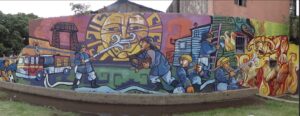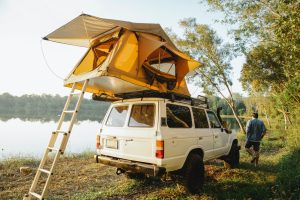The return home after months of motorcycle travel through South America was momentarily joyous but within days it became dour. The often experienced blues of a newly returned traveler hit hard and lingered for months. A loss of self, reduced sensory stimulus, and a redialing of perspective knocked me down from my world-traveling-I-can-conquer-all confidence. It didn’t help that I had no money, went right back to working multiple dead-end jobs to fill the coffers, and my relationship with Jade was clearly running its course toward demise.
Thankfully, I still had my motorcycle waiting for me in San Juan, Argentina and thus I had a goal to pursue, rather than float forlornly while I battled my exacerbated existential crises. Six months of grinding away as a bartender, waiter, caterer, and Christmas tree decorator all while living with my parents, enabled me to return to the South American continent for a couple more months of adventure, freedom, and to sell my motorcycle at the end of the world.

Buenos Aires
Packing my bags for the return to South America felt quite different from the year before. This felt like a business trip – a trip I was versed in and prepared for. The year before I was losing sleep about whether I’d even remember how to ride a motorcycle or worse, kill myself on the road. Now, I felt like I was on a mission. I had to get my motorcycle from northern Argentina, in and out of Chile, through Patagonia, and down to the most southern city in the world, Ushuaia. And it all had to be finished before the rapid approach of the harsh Patagonian winter.
Leaving in late January from the frigid mound that is Omaha, Nebraska, a series of stuffy flights with subpar food landed me in the historic city of Buenos Aires. In true masochistic form, I signed up for a three hour walking tour as soon as I got to my hostel. It was a great introduction to the city and it illuminated the dizzying array of architectural styles that were enrolled in its creation. Colonial, neoclassical, art nouveau, eclecticism, art deco, and modern designed buildings featured in varying smatterings. Most were beautifully executed – a few were a symbolic identity crisis – almost all needed the grime cleaned off of them.
Equipped with some knowledge of Argentina, its history and its current economic situation, I knew the general social mood was at best melancholic and at worst, tense and violent. The mixture of graffiti (non-art kind) and police barricades around Casa Rosada (Pink House – The Argentinian White House) added to the obvious discontent with the political and economic situations.

On top of this, it was made clear from my arrival and reiterated multiple times that theft and robbery was a massive problem in the city. At the top of the list were tourists; especially in the area of the city where black market currency transactions happen. Many tourists, not wanting to pay the ridiculous government imposed exchange rates, sought out black market currency dealers.
While possible to safely make these transactions, criminals openly target tourists that are carrying lump sums of cash for these attempted transactions. Various schemes and robbery stories were shared by travelers in the hostel, including the recent broad daylight murder of a gringo who refused to hand over his bag. Despite the atrocious fixed exchange rate of the banks, I decided that I would forgo the black market currency exchanges, at least in Buenos Aires.

Museum of Modern Art
The following day, after befriending a talkative Polish-Belgian in my hostel, we headed to the truly massive Sunday market on Ave. Defensa. We walked for what seemed like forever and still never got to the end of it. Instead, we went to the Museo de Arte Moderno de Buenos Aires (MAMBA) in the San Telmo neighborhood.

Works by Dalí, Picasso, and Matisse were a pleasant surprise but it was the brilliant work of León Ferrari that snared and captivated. I had never seen anything like it before. His protest art utilized a multitude of mediums but especially calligraphic writing, plaster, ceramics, wire, wood and collage. His targets of protest were typically the Catholic Church and oppressive governments – which we could argue have been one and the same for much of history. For his troubles, Ferrari was exiled to Brazil for 15 years and his son was abducted and murdered by the Argentinian dictatorship. When that reality is overlaid onto powerful art, the weight of the creation is felt in even greater magnitudes.

Graffiti Tour & La Boca
Boarding a Graffitimundo tour bus in the famed neighborhood of La Boca, a dozen of us drove around admiring colorful murals while the guide explained the context and intent of the work. We were also led around on foot at points for a more intimate take. The street art eye candy was in full effect with the unique creations and deep expression of the local sentiment. A wonderful excursion it was; do go.

A couple of days later, I was back in La Boca with my Polish-Belgian and English hostel friends from the hostel. The vibrantly colored neighborhood is home to the Boca Juniors soccer stadium; a storied franchise that ultimately divides Argentina into either Boca or River Plate fans. Even if an Argentinian supports a different club in another part of the country, they still have an opinion on either Boca Juniors or River Plate. Sports rivalries are their own religion.

Following our jaunt to La Boca, we took a taxi to the waterfront where we excitedly ordered a 3 liter tube/tap of beer. The novelty of the ice cold personal beer tap on a hot day seemed to smooth over any objections to the slightly off taste of the brew. If I had known what demons this concoction would hatch within me, I would have politely burned the bar to the ground and asked for a refund.

So Sick
At about 3 AM, I started vomiting. You know its bad when you wake up to raging nausea, fever, sweats, and overall sensations of desired death gripping your body and mind.
At about 9 AM I decided to ask the hostel reception to please call and rebook my 6 PM overnight bus ride. There was no chance I was going to sit in a bus for 18 hours when I couldn’t keep a lid on my liquids.
All day I lay down in the sporadically functioning air conditioning. At around 10 PM I mustered up enough energy to go downstairs to the convenience shop to buy some chips & ice cream (a dubious choice) – about all that sounded appealing at the time. I ate it, pounded down some water and went to bed.
Then the shits started.
What was meant to be a delicate release of pressure instead yielded a greasy secretion of despair. I SHIT MY PANTS IN BED! An awful feeling it is at the best of times but when stacked on a mountain of nausea and you’ve got yourself a fragile and humbled traveler that just wants the sweet release of death.
Not one to lay in my own shit, I carefully got up, grabbed my soap, towel, a change of underwear, and gingerly made my way to the bathroom. Two shits, two showers, and lots of sweating later, I was clean and cleaned out.
Shaking with the chills, I climbed into bed, careful not to fart, and passed out in minutes.
Feeling considerably better the next day, I ate breakfast – my first real meal in almost two days. My Belgian friend revealed to me then that he was sick too, but not as bad. Working backwards, we deduced that the obvious culprit was the tainted beer. Bastardos.
With my stomach mostly settled and my cells once again rehydrated, I headed to the bus station to catch a coach to San Juan to get my motorcycle. My Polish-Belgian friend helped me transport all of my bags of gear and find my platform. Once again faced with another bittersweet goodbye, we hugged, and just like that I was on the road again.
Next stop: Chapter 21: Rd. 2 of Immense Argentinian Hospitality
Start this journey from the beginning: Introduction
For more on Buenos Aires’ architecture, check out this article.









